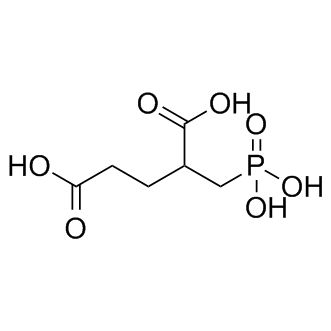| References: |
2-PMPA is a potent and selective inhibitor of glutamate carboxypeptidase II (GCPII) with an IC50 of 300 pM.
InVitro: 2-PMPA is a potent and selective inhibitor of GCPII, an enzyme which catabolizes the abundant neuropeptide N-acetyl-aspartyl-glutamate (NAAG) to N-acetylaspartate (NAA) and glutamate. 2-PMPA demonstrates robust efficacy in numerous animal models of neurological disease. 2-PMPA is a highly polar compound with multiple negative charges causing significant challenges for analysis in biological matrices. 2-PMPA reduces ketamine-induced decrease of cell viability and increase of LDH levels in the mixed cultures but not in the neuronal cultures.
InVivo: Intraperitoneal administration of 100 mg/kg 2-PMPA results in maximum concentration in plasma of 275 μg/mL at 0.25 h. The half-life, area under the curve, apparent clearance, and volume of distribution are 0.64 h, 210 μg×h/mL, 7.93 mL/min/kg, and 0.44 L/kg, respectively. 2-PMPA at 250 mg/kg, in an anesthetized mouse, after an initial rise, produces a rapid decline and a striking attenuation in BOLD signals in gray matter. The signature of 2-PMPA on brain T2* signals in gray matter at both 167 and 250 mg/kg includes a significant initial rise lasting several minutes. 2-PMPA has neuroprotective activity in an animal model of stroke and anti-allodynic activity in CCI model. Administration of 2-PMPA (50mg/kg) produces a mean peak concentration of 2-PMPA of 29.66±8.1 μM. This concentration is about 100,000 fold more than is needed for inhibition of NAAG peptidase, and indicates very good penetration to the brain. Administration of 50 mg/kg 2-PMPA (i.p.) produces a continuously increasing extracellular NAAG concentration, which starts directly after application. |























